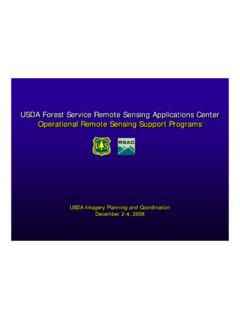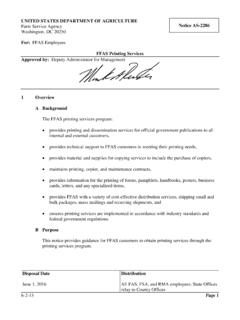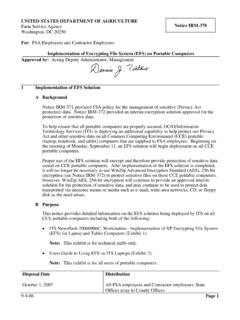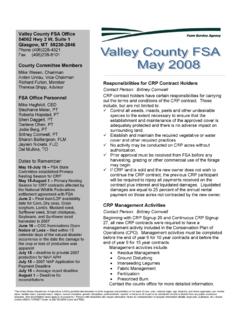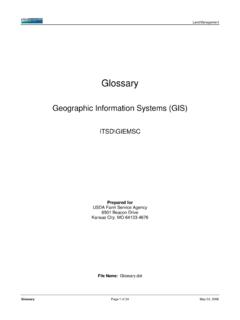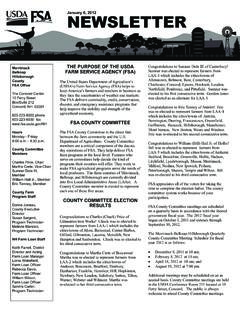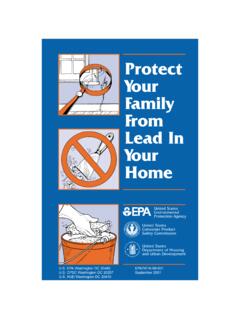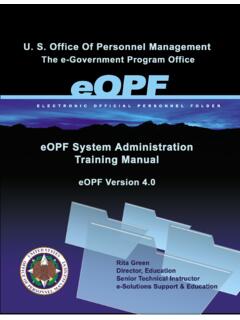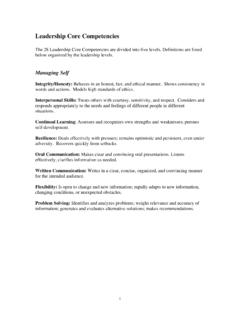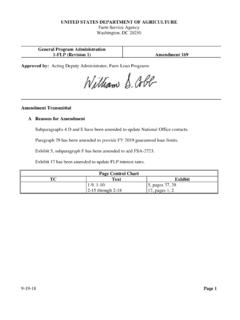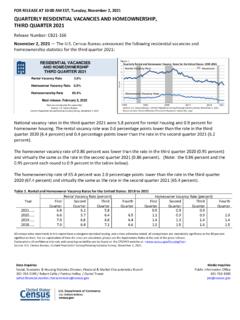Transcription of IRS Form 1099-G - Farm Service Agency
1 1 Crawford County FSA Office 3115 State Route 98 Bucyrus, Ohio 44820 419-562-8936 phone 419-562-8815 fax Hours Monday - Friday 8:00 - 4:30 County Office Staff Jim Greve, County Executive Director John Varner, farm Loan Manager Gail Walter, Kate Brause, Crystal McCown, Amy Seward, Program Technicians Randy Hiler, Ray Greenick, Field Reporters December 2010 Visit our Website at: DCP Sign-up & Advance Pay-ments Enrollment for the 2011 Direct and Counter-cyclical Program (DCP) has begun and will continue through June 1, 2011.
2 Advance payments of 22% on the 2011 DCP program will be available starting December 1, 2010. The remaining 78% of your DCP payment will be issued after October 1, 2011. Eligible producers receive direct payments at rates established by statute regardless of market prices. DCP contract signatures for enrollment are due by the sign-up deadline of June 1, 2011. For more information producers can contact their local FSA office. USDA Announces Support for Restoration of Nonindustrial Pri-vate Forest Land Damaged by Natural Disasters Assistance is available to help nonindustrial private forest (NIPF) landowners restore lands damaged by natural disasters.
3 The funds are provided through USDA s Emergency Forest Restoration Program (EFRP). Through this new program, USDA will continue to assist landowners in their efforts to im-prove the health of privately held forest lands EFRP participants will use the money to implement emergency forest restoration practices, including emergency measures necessary to address damage caused by a natural disaster to natural resources on NIPF land and restore forest health and forest re-lated resources on the land. The damage from the natural disaster must have occurred on or after Janu-ary 1, 2010 IRS Form 1099-G Producers annually receive CCC-1099-Gs detailing payments producers have received from the Com-modity Credit Corporation.
4 The annual report of program payments on CCC-1099-Gs is a Service in-tended to help our customers report taxable income. It is not intended to replace the producers responsi-bilities to report income to IRS. FSA staff cannot interpret IRS regulations or advise producers about which payments to report on their income tax returns. However, county office staff can review payments for accuracy. The program is administered by the farm Service Agency (FSA). To be eligible for EFRP, land must: Have existing tree cover (or had tree cover im-mediately before the natural disaster and is suit-able for growing trees); and, Be owned by any nonindustrial private individ-ual, group, association, corporation, or other private legal entity that has definitive decision-making authority over the land.
5 In addition, the natural disaster must create dam-age that, if untreated, would: Impair or endanger the natural resources on the land; and, Materially affect future use of the land. All of the above conditions must be met for EFRP eligibility. FSA county committees deter-mine land eligibility based on on-site damage inspections, taking into account the type and ex-tent of damage. Sign-up will begin Dec. 6, 2010 at your local FSA county office. For further information on how to apply and eli-gibility requirements for EFRP, NIPF landowners may visit their local county office where their farm records are maintained.
6 To read more about the EFRP, view the factsheet at: . Rural Youth Loans The farm Service Agency makes loans to rural youths to establish and operate income-producing projects in connection with 4-H clubs, FFA and other agricultural groups. 2 Projects must be planned and operated with the help of the organization advisor, produce sufficient income to repay the loan and provide the youth with practical business and educational experience. The maximum loan amount is $5000. Youth Loan Eligibility Requirements: Be a citizen of the United States (which includes Puerto Rico, the Virgin Islands, Guam, American Samoa, the Commonwealth of the Northern Mariana Islands)
7 Or a legal resident alien Be 10 years to 20 years of age Comply with FSA s general eligibility require-ments Reside in a rural area, city or town with a popula-tion of 50,000 or fewer people Be unable to get a loan from other sources Conduct a modest income-producing project in a supervised program of work as outlined above Demonstrate capability of planning, managing and operating the project under guidance and assistance from a project advisor. The project supervisor must recommend the project and the loan, along with providing adequate supervision.
8 To find out more about the FSA Rural Youth loan pro-gram, contact your local FSA county office to setup an appointment with a Loan Approval Official. Commodity Loans Producers considering a loan on their stored grain be-fore the end of the year will need to allow enough time before December 31st, to get the loan processed. Last second transactions that run into delays can be prob-lematic. Commodity loans, also referred to as Marketing Assis-tance Loans, are available to producers who share in the risk of producing the crop.
9 To be eligible, you must maintain beneficial interest in the crop through the time of application. Beneficial interest means retaining the ability to make decisions about the commodity; responsibility for loss or damage to the commodity; and title to the commodity. Once beneficial interest in a commodity is lost, the commodity is ineligible for loan even if you regain beneficial interest. Commodity loan eligibility also requires you comply with conservation and wetland protection require-ments; beneficial interest requirements, report how you use cropland acreage on the farm and ensure that the commodity meets CCC minimum grade and quality standards.
10 For commodities to be eligible they must have been produced by an eligible producer, be in ex-istence and in a storable condition and be merchant-able for food, feed or other uses as determined by CCC. The quality of the commodity in farm storage must be maintained throughout the term of the loan. Producers do not have to participate in the Direct and Counter-Cyclical Program to be eligible for commodity loans. Violating provisions of a marketing assistance loan may trigger administrative actions, such as assessing liqui-dated damages, calling the loan and denial of future farm -stored loans.
